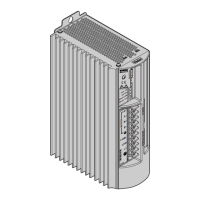30
Gemini GT Hardware Installation Guide
Use the following procedures to configure the stall detect settings.
Configuring Stall Detect
The DSTALL command sets the sensitivity for the stall detection circuitry. The default
setting is
disabled
. (DSTALL0)
NOTE: Match the motor to the load (see the procedure on the following pages)
before
you configure stall detect settings.
1. Enter an accurate value for LJRAT.
The LJRAT command sets the system’s load-to-rotor inertia ratio. LJRAT must be
set accurately in order for stall detect to function properly.
2. Begin configuration with low DSTALL values.
• 1 - 50 is the full range
•0 is
off
The table below lists effective ranges of DSTALL values. Enter a value, based on
your motor size:
Motor Frame Size: Size 23 Size 34 Size 42
DSTALL Value Range: 1 – 15 10 – 40 30 – 50
3. Verify the DSTALL value you entered by forcing a stall as you monitor TASX. At the
precise moment the stall occurs, TAS Bit #17 should be set. If Bit #17 is set before
or after the stall occurs, modify the DSTALL value as follows:
• If Bit #17 is set
before
the stall occurs,
decrease
the DSTALL value
• If Bit #17 is set
after
the stall occurs,
increase
the DSTALL value
NOTE: For the 6K to read and react to a GT fault, enter the command DRFEN1 for
each axis.
4. Run the system for an extended period of time to verify that no false stalls are
detected.
Configuring Fault on Stall Mode
1. If you enable the Fault on Stall mode (ESK1), the occurrence of a stall will immedi-
ately stop pulses from being sent to the motor and will disable the drive (DRIVE0)
2. If Fault on Stall is enabled (ESK1), the stall is reported by the following commands:
• TAS bit #12
• TER bit #1
NOTE: For the 6K to read and react to a GT fault, enter the command DRFEN1 for
each axis.
Procedure for Motor Matching
Due to slight manufacturing variations, each motor has its own particular charac-
teristics. The drive has three settings—phase offset, balance and waveform—that
can be adjusted to match the drive to a specific motor. The factory settings for
these parameters will be acceptable in most applications. If you need increased
smoothness or accuracy in your system, or if motor resonance causes vibration
problems, perform the following procedure. You will match your drive to your
motor by adjusting the drive settings, and selecting the best current waveform.
CAUTION
Verify correct series or parallel wiring. The label on the motor may be inaccurate if
the motor has been rewired after it left the factory.
Artisan Technology Group - Quality Instrumentation ... Guaranteed | (888) 88-SOURCE | www.artisantg.com

